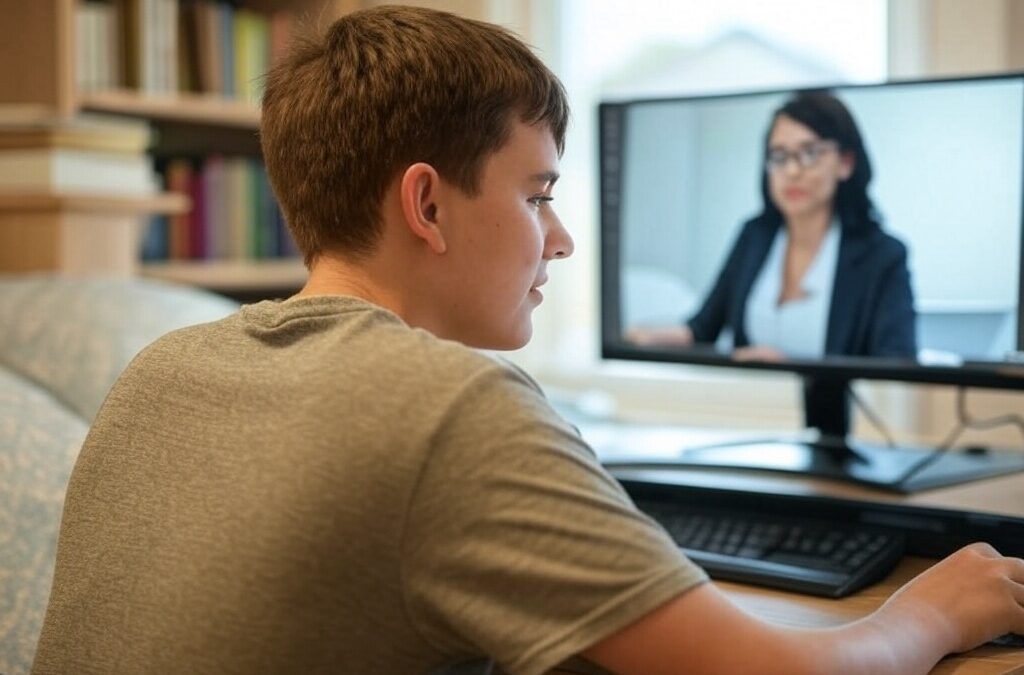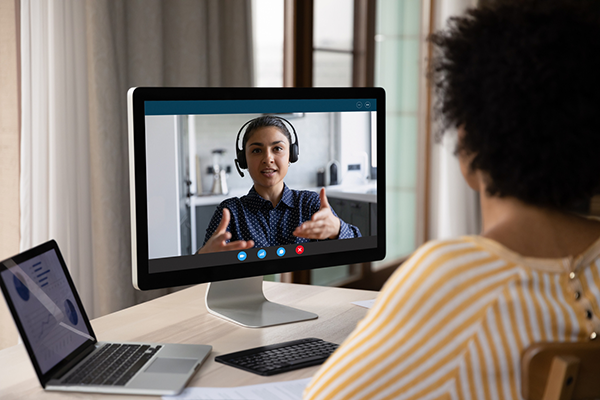
by TutorUp | Mar 20, 2025 | Online Tutoring
As a parent, you’ve likely noticed the ups and downs your child has faced in their education, especially in recent years. School disruptions, from pandemic-related closures to shifting schedules, have left many students grappling with learning loss. If you’re considering private, online tutoring to help your child catch up or even get ahead, you’re not alone. More parents are turning to this option, and for good reason: one-on-one online tutoring, delivered several times a week, has proven to be a powerful tool for boosting academic performance and remedying gaps in learning. Let’s explore why this approach might be the right fit for your child.
The past few years have underscored just how fragile academic progress can be. National testing data from 2022 revealed that students, on average, fell five months behind in math and four months in reading by the end of that school year, with even steeper declines for students in underserved communities. These setbacks don’t just disappear on their own—studies show they can linger, potentially costing students up to $61,000 in lifetime earnings if not addressed. That’s where online tutoring steps in as a targeted solution. Research consistently highlights its effectiveness, particularly when it’s personalized and frequent. A comprehensive review of 96 studies by the Annenberg Institute found that tutoring yields “consistent and substantial positive impacts” on learning outcomes, with gains equivalent to half a year to over a year of progress in just one academic year.
What makes one-on-one online tutoring so effective? It’s all about the tailored attention. In a typical classroom, teachers juggle the needs of 20 or 30 students, making it tough to zero in on your child’s specific strengths and struggles. Private tutoring flips that dynamic. Your child becomes the sole focus, allowing the tutor to adapt lessons to their learning style—whether they’re a visual learner who thrives on diagrams or a hands-on student who needs practice problems to grasp concepts. A study from San Bernardino Valley College showed that students receiving face-to-face tutoring (a close cousin to online one-on-one sessions) saw a 12% average increase in standardized test scores and outperformed their peers in 45 out of 52 academic subjects. Online tutoring mirrors this success, with the added flexibility of fitting into your family’s schedule.
Frequency matters, too. The evidence is clear: tutoring works best when it happens regularly—think three or more sessions a week, each lasting at least 30 minutes. This “high-dosage” approach, as experts call it, can accelerate learning by three to 15 months across grade levels, according to research from the Center for American Progress. It’s not just about cramming for a test; it’s about building a steady rhythm of support that reinforces classroom material and fills in gaps before they widen. For younger kids, like those in pre-K to first grade, reading tutoring has shown particularly strong results, while math tutoring shines for students in grades two through five. Imagine your third-grader, struggling with multiplication, finally clicking with the concept after consistent, focused help—online tutoring makes that possible without the logistical hassle of in-person sessions.
Beyond academics, there’s an emotional payoff. Kids often feel lost or anxious when they fall behind, and that stress can snowball into a lack of confidence. Regular one-on-one tutoring offers a safe space to ask questions and make mistakes, something they might shy away from in a crowded classroom. As their skills grow—say, moving from a C to a B in science—their self-esteem grows, too. Parents of upper-income households have caught on: one in five hired tutors during the pandemic to support distance learning, per the Pew Research Center. But you don’t need a big budget to see the benefits; online platforms have made tutoring more accessible, often at lower costs than traditional in-person options.
Of course, every child is different. If your kid thrives on structure and personal connection, the consistency of meeting the same tutor online several times a week could be a game-changer. Research from the National Student Support Accelerator shows that high-impact tutoring—small groups or one-on-one, frequent, and aligned with school content—moves the average student from the 50th to the 66th percentile. That’s not just a grade boost; it’s a leap toward excelling, not just catching up. So, is online tutoring right for your child? If they’re struggling with learning loss or simply ready to push their potential further, the data says yes—and the flexibility and proven results make it worth a serious look.

by TutorUp | Feb 19, 2025 | Online Tutoring
Nationwide, roughly 1 in 10 students participates in high-dosage, online tutoring (three or more tutoring sessions per week). This highly effective method has become increasingly popular, offering a blend of convenience, cost-effectiveness, and accessibility that traditional in-person tutoring might struggle to match. Here’s why online tutoring stands out as a compelling alternative:
- Flexibility and Accessibility: Online tutoring breaks the geographical barriers that in-person tutoring inherently faces. Students can now connect with top-tier tutors from anywhere in the world, without the constraints of location. This flexibility allows for scheduling that fits around busy lives, making education more accessible to those with tight schedules or living in remote areas.
- Example: A student in a rural town can now access a physics tutor from a prestigious university in another country, something virtually impossible with in-person tutoring.
- Cost-Effectiveness: Generally, online tutoring tends to be less expensive. Without the need for physical travel or maintaining a physical space, both tutors and students save on costs. This reduction in overhead often translates into lower rates for students.
- Insight: While in-person sessions might cost upwards of $60 per hour, online sessions can range from $20 to $60, making high-quality education more affordable.
- Enhanced Learning Tools: Modern online platforms come equipped with interactive whiteboards, screen sharing, and file sharing capabilities, which can sometimes offer a richer learning experience than traditional methods. These tools allow for real-time demonstrations, which are particularly beneficial for subjects like mathematics or sciences. Online sessions with one tutor and one student, face-to-face, are highly effective for tutoring.
- Technological Advantage: The use of technology in online tutoring can cater to different learning styles, providing visual, auditory, and interactive elements that might not be as dynamic in a physical setting.
- Personalization: One-on-one online tutoring can be highly personalized. Tutors can tailor their approach to individual learning styles, something that’s challenging in a classroom setting. The digital environment also allows for immediate access to a vast array of resources, which can be integrated into the lesson on-the-fly.
- Personalized Learning: Tutors can quickly adjust their teaching methods based on real-time feedback, ensuring the material is understood at the student’s pace.
- Safety and Comfort: Learning from home or a chosen environment can reduce anxiety for some students, providing a comfort zone that might enhance learning. This aspect is particularly noted in discussions around mental health and education.
- Comfort Factor: Students who might feel anxious in a formal classroom setting can find online tutoring more comfortable, potentially leading to better engagement and learning outcomes.
- Environmental Impact: While not directly related to learning effectiveness, the environmental benefits of reducing travel for tutoring sessions contribute to a broader educational ecosystem that values sustainability.
However, it’s worth mentioning that online tutoring isn’t without its challenges. The effectiveness can heavily depend on the student’s discipline, the quality of the internet connection, and the setup of the learning environment. For subjects requiring physical interaction or hands-on activities, in-person tutoring might still be preferred.
The effectiveness of online one-on-one tutoring as an alternative to in-person sessions is well-supported by its advantages in flexibility, cost, and technological integration. While it might not replace in-person tutoring entirely, especially for subjects requiring physical demonstration, it stands as a robust alternative that caters to the modern learner’s needs. The key to its success lies in leveraging technology to enhance, not just replicate, the traditional tutoring experience. For many, this digital shift in education represents not just an alternative but an evolution in how we approach personalized learning.

by TutorUp | May 13, 2024 | Education Topics, Parent and Tutor Resources
Reading is a foundational skill that shapes a student’s academic success and lifelong learning. Yet, many students across the United States struggle to reach the reading proficiency expected for their grade level. This gap not only hampers their performance in school but also affects their confidence and future opportunities. Addressing this issue requires understanding what reading levels mean, recognizing the scale of the problem through statistics, and implementing effective solutions like one-on-one tutoring to help students catch up.
What Do Reading Grade Levels Mean?
Reading grade levels indicate the expected reading ability of a student based on their school year. These levels are often measured using standardized assessments, such as the National Assessment of Educational Progress (NAEP), which categorizes proficiency into four tiers: Below Basic, Basic, Proficient, and Advanced. Here’s a breakdown of what these levels typically represent across key grade milestones:
- Grade 1 (Ages 6-7): Students should recognize letters, decode simple words, and read basic sentences with support. This aligns with a reading level of about 1.0–1.9 on many scales, focusing on phonics and sight words.
- Grade 4 (Ages 9-10): By this stage, students are expected to read fluently, comprehend short chapter books, and infer meaning from text. The NAEP “Proficient” level for fourth graders includes understanding main ideas and vocabulary in context, roughly equivalent to a 4.0–4.9 reading level.
- Grade 8 (Ages 13-14): Eighth graders should handle complex texts, such as novels or informational articles, analyzing themes and drawing conclusions. Proficiency here corresponds to a reading level of about 8.0–8.9, requiring strong comprehension and critical thinking.
Being “below grade level” means a student struggles with the skills expected for their age group. For example, a fourth grader reading at a second-grade level might still stumble over multisyllabic words or miss the main point of a story, putting them at a disadvantage across subjects.
The Scope of the Problem: Statistics on Reading Struggles
Recent data paints a sobering picture of how many students are falling behind in reading. According to the 2022 Nation’s Report Card from the NAEP, 66% of fourth graders in U.S. public and non-public schools scored below the Proficient level in reading, with 31% falling Below Basic. For eighth graders, the numbers are even starker: 69% were below Proficient, and 30% were Below Basic. These figures reflect a persistent challenge, worsened by disruptions like the COVID-19 pandemic, which saw kindergarten reading readiness drop from 55% to 37% between 2019 and 2020.
The National Center for Education Statistics (NCES) further reported in 2023 that nearly half (49%) of public school students started the 2022–23 school year behind grade level in at least one subject, with reading often cited as a primary area of concern. Pre-pandemic, this figure was lower at 36%, underscoring the lasting impact of learning loss. Additionally, over 54% of American adults read below a sixth-grade level, suggesting that early struggles can persist without intervention.
These statistics highlight a critical issue: millions of students are not equipped with the reading skills needed to succeed academically or engage fully in society. The consequences are profound—students who lag in reading by third grade are four times less likely to graduate high school on time, a risk that jumps to six times for those from low-income families.
A Proven Solution: One-on-One Tutoring
To bridge this gap, one-on-one tutoring stands out as a highly effective strategy. Unlike classroom instruction, which must cater to a group, personalized tutoring tailors lessons to a student’s specific needs, pace, and learning style. Research consistently supports its impact. A 2020 meta-analysis by the Annenberg Institute found that high-dosage tutoring—defined as at least 30 minutes, three times a week with a trained tutor—can boost learning by three to 15 months across grade levels. For reading specifically, Johns Hopkins University studies show one-to-one tutoring outperforms other interventions, like small groups or computer-based programs, especially for students far below grade level.
Why does it work? One-on-one tutoring allows tutors to pinpoint gaps—like weak phonics or poor comprehension—and address them directly. It also builds confidence through consistent, supportive feedback, which is crucial for students who feel discouraged. For instance, a struggling fourth grader might work with a tutor on decoding skills using engaging texts at their current level, gradually building up to grade-appropriate material. This individualized approach contrasts with the one-size-fits-all nature of many classrooms, where teachers juggle diverse needs.
Moreover, tutoring can integrate with school curricula, reinforcing classroom learning. Programs like Reading Partners demonstrate this success, showing significant gains in phonological skills and verbal ability through structured, one-on-one sessions. With only 11% of public school students currently receiving high-dosage tutoring (NCES, 2023), scaling up access could transform outcomes for the millions lagging behind.
Moving Forward
The reading crisis among students demands urgent action. With nearly two-thirds of fourth and eighth graders below proficiency, and half of students starting the year behind, the stakes are high. One-on-one tutoring offers a practical, evidence-based way to help students catch up, equipping them with the skills to thrive academically and beyond. Schools, districts, and communities must prioritize funding and implementing these programs, ensuring every child gets the chance to read at their potential. The investment isn’t just in literacy—it’s in their future.

by TutorUp | Dec 1, 2022 | Online Tutoring
Student Achievement Suffered Due to Remote Learning
In an article published this week by Education Week, reporter Mark Lieberman discusses the continued debate over the harms of extended remote learning. He cites a report published on November 28 from the American Enterprise Institute that “found that districts that stuck with full-time remote learning for longer in the first year of the pandemic saw larger declines in enrollment in subsequent school years” and that these findings showed clear signs that remote learning was among the factors that “diminished academic achievement for millions of students in the last couple of years.”
What Do They Mean by “Remote Learning?”
A definition is in order here, to make sure we all understand what they are talking about. Remote learning was the quickly constructed “solution” to schools that were closed to in-person learning due to the COVID-19 pandemic and lockdowns. Initially it was thought this would be a short-term solution, but school districts, parents, teachers, politicians, and others were reluctant to send students back to school while there was an increase in infections and uncertainty about how it would affect students in the school environment. So “online school” lasted much longer than first anticipated. Starting in the final months of the 2020-2021 school year, many schools kept students at home for many more months, or even the entire school year of 2021-2022. Other schools implemented a hybrid approach, where students attended 2 or 3 days in person, with the remaining days remote.
Remote learning was not a universally built and deployed replacement for in-person school, and some things quickly became clear. Not all students had the technology or the internet access needed to participate. Even those who did had to share that computer and internet access with siblings and parents who were suddenly working from home. At a particular disadvantage were students in lower-income areas. This was a huge contributor to student dropout rates and low attendance, as recent research showed.
Teachers were also inexperienced with the new format and struggled to translate classroom activities to online gatherings. As teachers dropped out, the ones who were left found themselves with even greater responsibilities and challenges. In most cases, there was little to no training or preparation for this new reality, and teachers struggled to do their best.
If Remote Learning is Bad, What About Online Tutoring?
There can’t be many people who aren’t aware of how much time we all spend staring at screens. “Globally, people average 6 hours 58 minutes of screen time per day. The average American spends 7 hours and 4 minutes looking at (an internet-connected) screen each day,” according to Digital Information World. Gen Z spends around 9 hours per day looking at a screen. For the average US teen, this breaks down to:
- Watching TV/Videos – 3 hours 16 mins
- Gaming – 1 hour 46 mins
- Social Media – 1 hour 27 mins
- Browsing Websites – 51 mins
- Other – 29 mins
- Video Chatting – 20 mins
- E-reading – 15 mins
- Content Creation – 14 mins
Additionally, 88 percent of parents report that their children between 0 and 11 years old are watching TV, 67 percent are using tablets, 60 percent are using smartphones, 44 percent are using a desktop/laptop, and 44 percent are gaming.
In light of this, what are the reasons to consider online tutoring for your child?
It’s One-to-One
Unlike remote learning, where there is one teacher for dozens of students, lecturing, assigning homework, and trying to keep students engaged, online tutoring is one tutor with one student, no distractions.
Content is Highly Personalized
The tutor is able to assess the student’s needs and tailor the subject, teaching method, and support to match that student’s needs.
Short, Variable-Length Sessions
Unlike remote learning, which required hours of sitting in front of a computer screen, online tutoring sessions are short and the time length is flexible, based on student age and attention-span and the difficulty of the subject matter.
Convenience Factor
Tutors and parents decide on a mutually convenient schedule. Families have a lot of activities going on, and the online format means you don’t have to drive somewhere. You choose the day/time that works best for your schedule, in the convenience of your own home.
Parents Have Total Visibility to Their Child’s Learning
Since sessions are online, parents can watch live or even record their child’s sessions, ensuring that they have complete visibility to what goes on in the tutoring session.
Parents Choose Their Child’s Tutor
In school, it’s the luck of the draw when it comes to which teachers your child spends the day with. With online tutoring, you review the available tutors and choose the one you think is the best match for your child. And you can always switch tutors if you find it’s not the best match after all.
How TutorUp Can Help
At TutorUp, all of our tutors are certified, classroom-experienced teachers. This means that they are not just subject matter experts in whichever subject your child needs help with. They are also trained educators who can assess a student’s needs and adapt their teaching approach to best help each student. They know how to evaluate the effectiveness of their tutoring and provide meaningful feedback to parents.
Contact us today so we can help your child succeed.

by TutorUp | Dec 21, 2020 | Online Tutoring, Parents and Home
There are basically four main learning styles for children (and adults): Visual, Auditory, Tactile, and Kinesthetic. Most children fall into a combination of styles, but you can usually identify one style that seems to be the most successful.
Four Basic Learning Styles
- Visual Learners learn through seeing. Showing works better than explaining.
- Auditory Learners learn through listening. Explaining and discussing things is the best way to reach them.
- Tactile Learners learn through touch. Being able to use their hands, reading, writing, and even doodling or drawing, helps them learn.
- Kinesthetic Learners need to move and do. The kinesthetic learner may have trouble sitting still and needs to be able to be active in order to stay engaged.
No surprise that experts don’t all agree, and many of them break down these four basic learning styles into more specific niches. The important thing is to be able to recognize what works for your child, and use that knowledge to help them succeed.
Practical Application in the Classroom
Now imagine that you have a classroom of twenty students, and they all have slightly different learning styles that work for them. And they are all at different levels of comprehension and mastery of a specific subject or concept. It is clearly a huge challenge to try to meet those individual needs and ensure that everyone in the class is “getting it”.
If you are the parent of a student who may be struggling to keep up, or just needs a little extra one-on-one attention to achieve mastery of a subject, private tutoring is an effective option. Even the most accomplished students benefit from having the teacher’s undivided attention to ask questions and get answers.
Pandemic Learning Loss
This is even more true over the past year where we have seen students who normally don’t have a problem in school who are now falling behind. It may be directly related to the switch to online learning, part-time school, and the inherent inadequacies of these models, or it may also be related to the social isolation, uncertainty, and anxiety they feel.
Whatever the cause, studies are showing impressive gains for students who are trying to combat COVID learning loss by receiving online tutoring. Scientific American has published data from an analysis of 96 different tutoring models, and found that “80 percent of the studies led to markedly improved outcomes, with more than half of the studies reporting large gains as a result of these programs. In education research, such consensus is a rarity, and the consistency and magnitude of the results are both remarkable and encouraging.”
An Italian study has shown that middle school students who received three hours of online tutoring a week saw a 4.7 percent boost in performance in math, English and Italian. With six hours of tutoring support, improvement doubled. They have seen similar results in online tutoring programs in the United States and the results of these different tutoring programs “suggest that tutoring is a key tool in keeping students engaged and combatting the growing COVID-19 learning loss.”
One Size Doesn’t Fit All
Trained educators are able to assess a student’s performance and learning style and can adapt lessons to suit. Tutors who are subject matter experts but are not trained teachers may know their subject cold, but it doesn’t mean they are equipped to teach a struggling student.
At TutorUp, all of our tutors are certified, background-checked, experienced teachers, and we match your student’s specific needs with the perfect tutor from our database of over 3,000 professionals. We facilitate the matchup, you schedule sessions at your convenience, and the teacher/tutor provides session recaps for every tutoring session.
We have three different solutions for families looking for personalized online tutoring
Individual Sessions
To see if our online tutoring is the right fit for your student, we offer the opportunity to purchase one hour at a time, or you can take advantage of our introductory offer for new students, where you can purchase 3 hours of tutoring and get a 4th hour for free.
Package Pricing
For students who would benefit from more than a couple of tutoring sessions, we offer package pricing at a discount from the individual session price. You can purchase 8, 16, or 24 hours and they never expire, so you can use them as needed.
Subscription Pricing
Our very best value is our subscription model, where you sign up for 4, 8, 16, or 24 hours of tutoring per month, on a recurring basis. Unused hours roll over to the next month, and you may cancel anytime.
To find out more, Get Started here.






